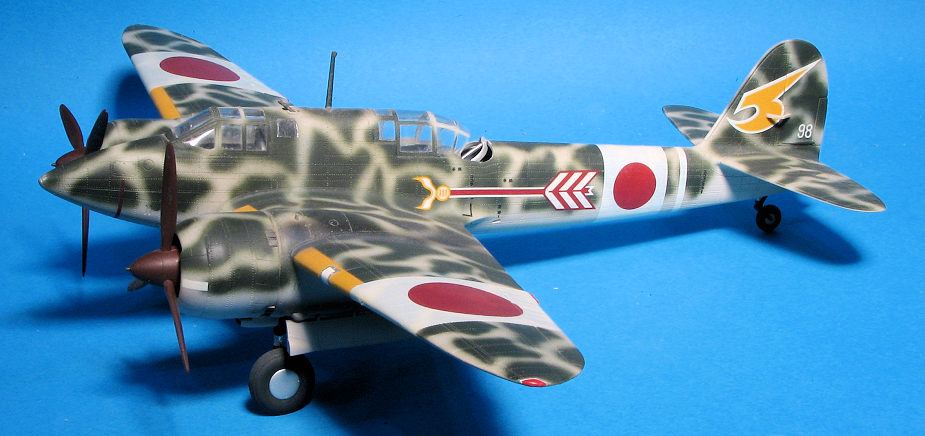
| KIT #: | 19 |
| PRICE: | $ |
| DECALS: | Two options |
| REVIEWER: | Scott Van Aken |
| NOTES: |

| HISTORY |
The Ki-45 was initially used as a long-range bomber escort. The 84th Independent Flight Wing (Dokuritsu Hikō Chutai) used them in June 1942 in attacks on Guilin, where they encountered, but were no match for, Curtiss P-40s flown by the Flying Tigers. In September of the same year, they met P-40s over Hanoi with similar results. It became clear that the Ki-45 could not hold its own against single-engine fighters in aerial combat.
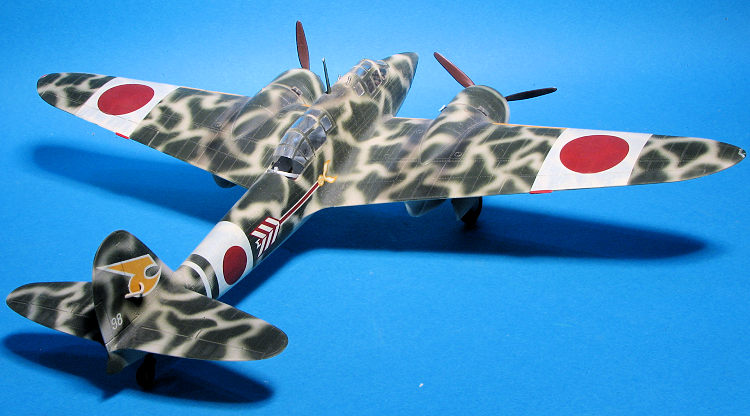 It was
subsequently deployed in several theaters in the roles of interception, attack
(anti-ground as well as anti-shipping) and fleet defense. Its greatest strength
turned out to be as an anti-bomber interceptor, as was the case with the Bf 110
in Europe. In New Guinea, the IJAAF used the aircraft in an anti-ship role,
where the Ki-45 was heavily armed with one 37 mm (1.46 in) and two 20 mm cannons
and could carry two 250 kg (550 lb) bombs on hard points under the wings. 1,675
Ki-45s of all versions were produced during the war.
It was
subsequently deployed in several theaters in the roles of interception, attack
(anti-ground as well as anti-shipping) and fleet defense. Its greatest strength
turned out to be as an anti-bomber interceptor, as was the case with the Bf 110
in Europe. In New Guinea, the IJAAF used the aircraft in an anti-ship role,
where the Ki-45 was heavily armed with one 37 mm (1.46 in) and two 20 mm cannons
and could carry two 250 kg (550 lb) bombs on hard points under the wings. 1,675
Ki-45s of all versions were produced during the war.
The first production type (Ko) was armed with two 12.7 mm (.50 in) Ho-103 machine gun in the nose, a single Type 97 20 mm cannon in the belly offset to the right, and a trainable 7.92 mm (.312 in) machine gun in the rear cabin; this was followed by the Otsu with the lower 20 mm cannon replaced by a 37 mm (1.46 in) type 94 tank gun, to counter B-17 Flying Fortress bombers. While the firepower was devastating, manual reloading meant that typically only two rounds could be fired on each gunnery pass. The next type (Hei) restored the 20 mm cannon, and this time placed an automatic 37 mm (1.46 in) gun in the nose. A later addition in the "Tei" type were twin obliquely-firing 20 mm Ho-5 cannons behind the cockpit, and often propulsive exhaust stacks.
Soon after entering service, the Ki-45 was assigned to
home defense, and several were dispatched against the Doolittle raid, though
they did not see action. The craft's heavy armament proved to be eff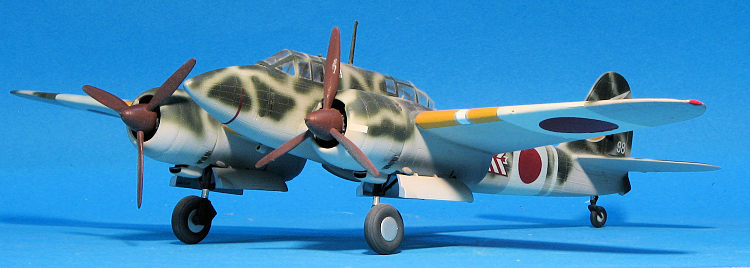 ective
against the B-29 Superfortress raids which started in June 1944. However, its
performance was insufficient to counter B-29s flying at 10,000 m (32,800 ft).
Modifications such as reduction of fuel and ordnance were attempted to raise
performance, to little avail, and in the end aircraft were used effectively in
aerial ramming attacks. They were also used in
kamikaze attacks, such as the attack on USS
Dickerson on 2 April 1945 off
Okinawa. The commanding officer and 54 crew were killed when a Toryu clipped the
stacks from astern, and rammed the bridge. A second Toryu hit the foredeck,
opening a 7 m (23 ft) hole in the deck. The ensuing fires demolished the ship,
and after the surviving crew was rescued by fellow fast transports and
ex-destroyers Bunch and
Herbert, the ship was
towed out to sea and scuttled.
ective
against the B-29 Superfortress raids which started in June 1944. However, its
performance was insufficient to counter B-29s flying at 10,000 m (32,800 ft).
Modifications such as reduction of fuel and ordnance were attempted to raise
performance, to little avail, and in the end aircraft were used effectively in
aerial ramming attacks. They were also used in
kamikaze attacks, such as the attack on USS
Dickerson on 2 April 1945 off
Okinawa. The commanding officer and 54 crew were killed when a Toryu clipped the
stacks from astern, and rammed the bridge. A second Toryu hit the foredeck,
opening a 7 m (23 ft) hole in the deck. The ensuing fires demolished the ship,
and after the surviving crew was rescued by fellow fast transports and
ex-destroyers Bunch and
Herbert, the ship was
towed out to sea and scuttled.
In 1945, the forward and upward-firing guns showed some results with the commencement of night time bombing raids, but the lack of radar was a considerable handicap. By the spring of 1945, the advent of American carrier-based fighters and Iwo Jima-based P-51s and P-47s escorting B-29s over the skies of Japan brought the Ki-45's career to an end.
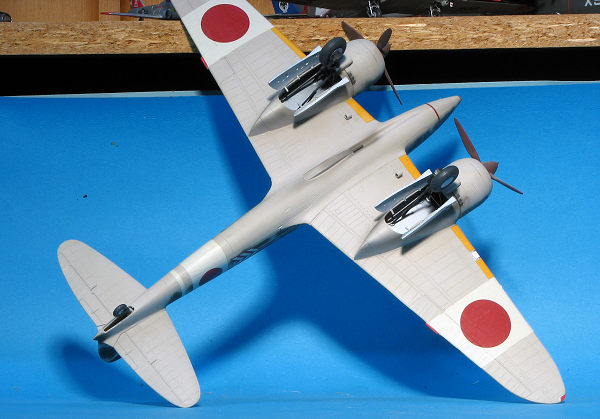 The next
version, the Kawasaki Ki-45 KAId, was developed specifically as a night fighter,
which were supposed to be equipped with centimetric radar in the nose; due to
production difficulties, this did not occur. The aircraft took part in night
defense of the Home Islands and equipped four
sentais from the autumn of 1944 to the war's end.
They obtained notable successes, and one Ki-45
sentai claimed 150 victories, including eight USAAF
B-29 Superfortresses in their first combat.
The next
version, the Kawasaki Ki-45 KAId, was developed specifically as a night fighter,
which were supposed to be equipped with centimetric radar in the nose; due to
production difficulties, this did not occur. The aircraft took part in night
defense of the Home Islands and equipped four
sentais from the autumn of 1944 to the war's end.
They obtained notable successes, and one Ki-45
sentai claimed 150 victories, including eight USAAF
B-29 Superfortresses in their first combat.
The Ki-45 was to be replaced in the ground-attack role by the Ki-102, but was not wholly supplanted by the war's end.
Three Ki-45s fell into communist Chinese hands after World War II. Unlike most captured Japanese aircraft, which were employed in the training role, the three Ki-45s were assigned to the 1st Squadron of the Combat Flying Group in March 1949 and were used in combat missions. These aircraft were retired in the early 1950s.
| THE KIT |
Not all that many people know a lot about Nichimo. They have been around for quite a while and while some of their models include toy-like features (folding wings, motor for the prop), they have or had the distinction of doing kits that others did not. Still no 1/48 scale Jake from any of the majors, but Nichimo did one.
 The
Ki-45 (pronounced Key-45) is a surprisingly modern kit considering its age. All
engraved panel lines with engraved rivet detail. A pretty complete cockpit that
really only lacks a bit of additional detail, like seat belts to bring it to
modern specs. There are not really any optional pieces with this as the Ki-45
spent most of its wartime career as a heavy fighter and was actually fairly good
at it. The clear pieces are all well formed and have distinct frame lines, which
makes it easy to mask. The engines are nice representations as well and thanks
to the close cowling and large spinners, not much will be seen.
The
Ki-45 (pronounced Key-45) is a surprisingly modern kit considering its age. All
engraved panel lines with engraved rivet detail. A pretty complete cockpit that
really only lacks a bit of additional detail, like seat belts to bring it to
modern specs. There are not really any optional pieces with this as the Ki-45
spent most of its wartime career as a heavy fighter and was actually fairly good
at it. The clear pieces are all well formed and have distinct frame lines, which
makes it easy to mask. The engines are nice representations as well and thanks
to the close cowling and large spinners, not much will be seen.
Instructions are mostly in Japanese and there are generic paint references. Decals are for two planes of the 53rd Hiko Sentai, a unit much photographed in the last year of the war as they operated on homeland defense. At the time I built this kit (late 1980s), the decals were still quite fresh and thanks to a paucity of aftermarket for this kit at the time, I used them.
| CONSTRUCTION |
Due to a lack of available articles from readers, I pulled this one from the shelf, dusted most of the dust from it and decided to write a review. Now my mind is still sharp, but remembering back nearly 30 years for minute details is not always easy.
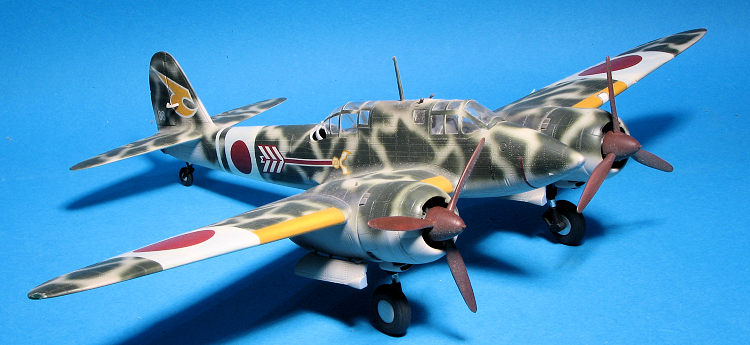 One thing I
can tell you is that this kit goes together very well. Not much in the way of
fiddly bits as most of the detail is molded in place. No separate exhaust, not
even a landing light is included. There isn't much detail in the gear well and
those areas I painted silver. I also painted the cockpit in aluminum, though I
now know that many Kawasaki planes were painted a sort of tan shade. There are
no decals for the instruments so those were painted white
One thing I
can tell you is that this kit goes together very well. Not much in the way of
fiddly bits as most of the detail is molded in place. No separate exhaust, not
even a landing light is included. There isn't much detail in the gear well and
those areas I painted silver. I also painted the cockpit in aluminum, though I
now know that many Kawasaki planes were painted a sort of tan shade. There are
no decals for the instruments so those were painted white
I do recall one area where I had a bit of trouble and that is the installation of the cannon trough on the underside of the fuselage. It took a bit of work to get it in place. Also note that getting the upper fuselage guns properly aligned was a bit tricky as well. Aside from that, while not a slap together, the kit did assemble quite well.
| COLORS & MARKINGS |
The main reason I wanted to build this one was the paint scheme. Back then, I pretty much used only Gunze acrylics. They seemed to work best for painting in an apartment, were easy to get locally, and covered well. At the time, I used a Badger 150 and thanks to the acrylic, the painting task was rather long as the paint kept drying on the tip so it was 'paint a bit, wipe the tip, paint a bit' and so on. The entire airframe was painted with their IJAAF grey and then I used their IJAAF green for all the large mottles. There was considerable back and forth as I was unable to get as tight a pattern as I really wanted back then.
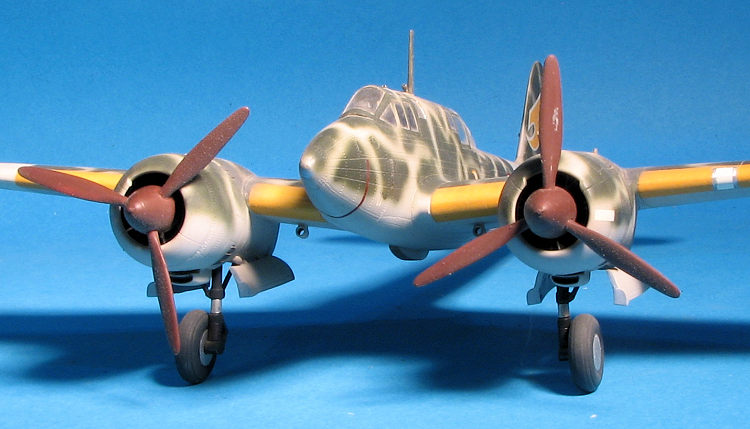 I then
sprayed on some clear gloss and used the kit decals for the markings. This
included the yellow wing ID bands. Apparently there were no issues with the
decals as they snuggled down nicely and succumbed to whatever setting solution I
was using with no silvering. Though the pictures do not show it all that well,
the white bands are not totally opaque so I'd recommend painting the white
bands. I did add some exhaust staining. Since there were no clear bits for the
landing or tip lights, those areas were first painted silver and then using
white, red, and green, painted in the appropriate colors.
I then
sprayed on some clear gloss and used the kit decals for the markings. This
included the yellow wing ID bands. Apparently there were no issues with the
decals as they snuggled down nicely and succumbed to whatever setting solution I
was using with no silvering. Though the pictures do not show it all that well,
the white bands are not totally opaque so I'd recommend painting the white
bands. I did add some exhaust staining. Since there were no clear bits for the
landing or tip lights, those areas were first painted silver and then using
white, red, and green, painted in the appropriate colors.
There are some bits that were added last including the pitot tube, which has been missing for a very long time, succumbing to a move, the radio mast, the under wing oil coolers and the rudder hinges. I also drilled out the coolers and the gun barrels. There is also no gun in the back as I did not install one, though the reason escapes me at the moment. Might have broken it removing from the sprue.
| CONCLUSIONS |
 Most current
modelers will gravitate towards the very much nicer Hasegawa kit when dealing
with this plane in this scale. That kit has a greater level of detail,
especially on the inside and is a much more modern kit design. However, if you
are not entering contests where minute detail is not a requirement and want a
rather trouble-free build, I do recommend locating one of these. A bit of
searching on both Google and Yahoo showed several for sale in the $30-40 range.
As a bit of an aside, I find that anymore, Yahoo's search engine pulls up a lot
more buying options when looking for kits than Google's. Not sure why, but there
it is. Anyway, if you find one, get some aftermarket markings and go for it.
Most current
modelers will gravitate towards the very much nicer Hasegawa kit when dealing
with this plane in this scale. That kit has a greater level of detail,
especially on the inside and is a much more modern kit design. However, if you
are not entering contests where minute detail is not a requirement and want a
rather trouble-free build, I do recommend locating one of these. A bit of
searching on both Google and Yahoo showed several for sale in the $30-40 range.
As a bit of an aside, I find that anymore, Yahoo's search engine pulls up a lot
more buying options when looking for kits than Google's. Not sure why, but there
it is. Anyway, if you find one, get some aftermarket markings and go for it.
| REFERENCES |
https://en.wikipedia.org/wiki/Kawasaki_Ki-45
August 2017
Copyright ModelingMadness.com. All rights reserved.
If you would like your product reviewed fairly and
fairly quickly, please
contact
the editor or see other details in the
Note to
Contributors. Back to the Main Page
Back to the Review
Index Page
Back to the Previews Index Page